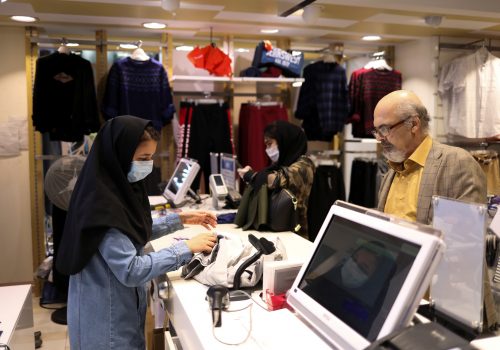Pressed by sanctions and coronavirus, can Iranian businesses bounce back?
There are currently no reliable, updated statistics on the coronavirus pandemic’s medium and long-term impact on businesses in Iran.
A report released by the Iranian Parliament’s Research Center (IPRC) on March 11 estimated, the burden on the country’s pension funds due to lost lives (between one thousand and four thousand) and increased unemployment (between one hundred thousand and two hundred thousand) at between 7,180-18,550 billion rials ($47.9 million to $123.7 million, using the exchange rate of 150,000 rials to the dollar at the time). Those numbers were certainly severe underestimations.
A more thorough report released by the same research center on April 27 stated that one impact of the pandemic would be a rise in inflation above 20 percent during the current Iranian calendar year (March 2020—March 2021). It also stated that the government’s initial expectations for non-petroleum-based GDP growth during the same period would not be met due to both US re-imposed sanctions and COVID-19, as well as decreasing domestic consumption of goods and services. Consequently, Iran’s GDP would—regardless of various recovery scenarios—fall between 7.5—11 percent, resulting in 2.8—6.4 million lost jobs. The report concluded that uncertainty along with economic stagnation or decline would cause many businesses to collapse. The report, thus, predicted increased poverty.
The International Monetary Fund (IMF) puts the inflation rate in Iran at 34.2 percent, the GDP growth rate at -6 percent, and unemployment at 16.3 percent in 2020.
Trying to cushion the blow, President Hassan Rouhani announced in March that the government would allocate 750,000 billion rials ($5 billion) to support businesses negatively affected by the pandemic. Ibrahim Doroosti, the Industry, Mine and, Trade Ministry’s liaison at Iran’s Chambers of Commerce, further announced in May that the allocated amount would be available as loans based on certain conditions, such as no lay-offs. The eligible businesses could thereby borrow between 120-160 million rials ($800-$1,100) per employee with a loan term of two years and an annual interest rate of 12 percent.
Iran’s economy, like that of any other country, is impacted by internal and external challenges. It is, however, more difficult to analyze and evaluate Iran’s business and financial numbers due to several reasons. The government often manipulates statistics for propaganda purposes, while businesses, contending with the government’s inefficient, complex, and corrupt practices, also falsify numbers. Different types of exchange rates (e.g. official, NIMA, floating) create another challenge to evaluate and anticipate the financial instruments and the outcome of business endeavors, economic strategies, and stimulus packages. The absence of transparency is a serious hindrance to fully grasping Iran’s financial ecosystem.
During the past four decades, Iranian entrepreneurs have always found ways of reviving business activities and productivity in times of crisis. However, current challenges are undermining those efforts and driving many Iranians into further poverty.
The external challenges are caused by US sanctions against Iran, which unfairly hit private businesses due to severed international financial links. These have constrained both exports of finished products and imports of necessary raw materials and machinery, impeded access to required software, and blocked online services such as Google, Apple, and GoFundMe.
The internal challenges are Iranian policymakers’ incompetence and lack of flexibility and engagement in supporting the private sector in a timely and proper manner, horrific bureaucracy, and corruption.
Ali Firozi, head of the National Business Environment Studies and Monitoring Center at the Iranian Economic Affairs and Finance Ministry, stated, in an interview with Iran Newspaper in April, that the COVID-19 crisis has caused a lot of damage to Iranian businesses, but that, on the other hand, the businesses will “benefit” after the crisis is over. Firozi did not, however, provide any explanation on how businesses could recover and capture what he called a “golden opportunity.” On the contrary, he emphasized that the economic support packages provided by the government should not necessarily be considered as the solution to recovery work, which might be interpreted as the government’s way of lowering expectations for a serious state contribution.
Iran’s request to the IMF for an emergency loan of $5 billion in April to fight the pandemic would primarily be earmarked for purchasing food, medicine, medical equipment, and other health-related goods and services, rather than aimed at assisting struggling businesses. A recent scandal about $4.8 billion going missing in government’s funds as well as the US attempt to block the loan to Iran have cast doubt on whether Iran will receive the funds.
While few businesses have financially benefited from the pandemic due to involvement in import, manufacturing and distribution of medicine, medical consumables and equipment, other businesses within consumer products, general commerce, tourism, knowledge-based companies and technical startups, transportation, and hospitality—to mention a few—have incurred tremendous losses that are estimated to be at least $2 billion per month.
Iranian businesses were already struggling prior to the COVID-19 crisis. Recovery suggestions such as product diversity strategy, which were recently proposed by Tehran University, are too simplistic and naïve. These analyses also misinterpret numbers to give the false perception that Iranian businesses are slowly bouncing back to a “satisfying” situation before the crisis and that they are even doing better than the previous year. Two of the important aspects missing in these suggestions are the significant role of the devaluating rial in causing companies to incur more losses, and the dire need for financial and regulatory reforms as prerequisites to a working post-crisis business ecosystem.
The pandemic and its consequential economic damages may deliver the final blow to many private companies in Iran. However, the private sector is capable of bouncing back and building a sustainable ecosystem if the government eases bureaucracy, including the unnecessary involvement of numerous parallel regulatory bodies belonging to the Justice Ministry, Intelligence Ministry, and the Culture and Islamic Guidance in every aspect of business. Another huge boon would come if the US sanctions are lifted, as they are equally responsible for depressing Iranian businesses and hurting the welfare of ordinary Iranians.
Mohsen Tavakol is an international business executive, technology entrepreneur, investor and advisor on sanctions, international trade compliance, and business ethics. He is also a nonresident senior fellow at Atlantic Council. Follow him on Twitter: @Mohsen_Tavakol.
Image: An employee of a stock brokerage firm monitors the stock prices on her computer, following the outbreak of the coronavirus disease (COVID-19), at the brokerage house in Tehran, Iran, May 12, 2020. WANA (West Asia News Agency)/Ali Khara via REUTERS


